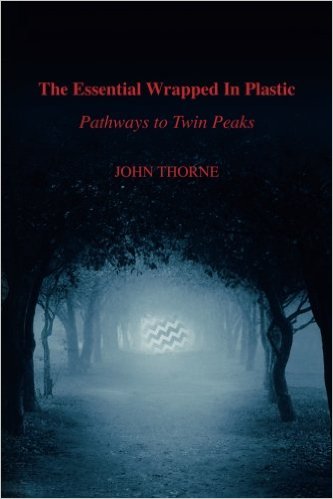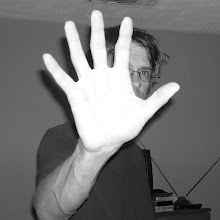I'm ending my review of Greg Olson's Beautiful Dark the way I began, by reviewing four chapters at once. Nice symmetry that.
To be honest I felt I was becoming a bit dependent on Olson's work to provide content for my blog. And I was afraid of becoming repetitive (if you've read my earlier reviews of Olson, you sort of know what to expect). So it's time to finish it up.
Here's a brief summary of the last four chapters:
Chapter 9: LOST HIGHWAY
Olson begins with a look at the long five years between Fire Walk With Me and Lost Highway. He discusses Lynch's often overlooked television work on On The Air and Hotel Room. And he digs deeper to talk about a few rare Lynch projects—the four Twin Peaks-themed Georgia Coffee commercials which aired in Japan, the Log Lady introductions Lynch shot for the Bravo TV re-airing of Twin Peaks, Lynch's superb book of photography, Images, and the short film, Premonitions Following and Evil Deed (which Lynch shot for Lumiere and Company, a compilation of short films by famous directors using the original hand-cranked film camera of film pioneers, Auguste and Louis Lumiere). These projects deserve discussion and Olson makes sure to give each project its due.
Olson moves on to an excellent, albeit too-short, analysis of Lost Highway. Olson's take is straightforward: Fred Madison, in despair over killing his wife and being sentenced to death, creates the imaginary persona of Pete Dayton in order to escape from his (Fred's) real world hell. Olson does a great job of taking the seemingly perplexing and contradictory Lost Highway, with its multiple personas and interlocking worlds, and clarifying it into one simple tale about a man whose fractured mind cannot provide enough escape from his torment. "The reading of Lost Highway that answers most of its mysteries locates the film's base reality with Fred lying on his prison bed, living in mental worlds of desire and anger, love and revenge" (p. 450). The idea of escape into a mental world is a concept that has always been a feature of Lynch's work. One finds the idea as early as Eraserhead and as late as Mulholland Drive. (I also believe that the idea of mental landscapes—or living inside dreams—is the key aspect of the first thirty minutes of Fire Walk With Me.) In Lost Highway, Lynch explores the mental escape (or retreat) of his main character and how such escape is temporary at best. You can't trick your own mind for very long. Olson's keen analysis provides satisfying answers to the many puzzles of Lost Highway.
Chapter 10: THE STRAIGHT STORY
Olson's discussion of The Straight Story focuses on Lynch's interest in family and small-town values (Olson notes that these ideas have been present in other Lynch works, but often overlooked or misunderstood by critics). He discusses much of the film's story and well-drawn characters but rarely ventures into any deeper analysis, content to let the surface narrative of The Straight Story stand for itself. This is a fair and fine reading of the film. But I suspect that there may be much more to The Straight Story for the diligent analyst to uncover. I've always been fascinated with Lynch's aerial shots in the film (particularly the one which shows Alvin Straight crossing the Mississippi River); they imply a watching, perhaps angelic, presence. There is also the prevalent theme of death in the film (one could argue that Alvin dies in the first few minutes of the film; the rest of his story is a post-death journey in search of his brother "in heaven"). I'm very interested in Alvin as an unreliable narrator (he claims to have given up drinking but orders a single beer late in the film). And I'm most interested in Alvin's encounter with the kindly farmer on the big tractor who guides Alvin to Lyle's home at the end of the film. This farmer (seen only in a long shot) acts almost like a supernatural being whose presence somehow reignites Alvin's stalled tractor (hence, the farmer potentially functions as another "angelic presence"). I find The Straight Story a fascinating and rich film and was perhaps unfairly expecting more from Olson. I accept that not every film requires a deep reading but because Olson succeeded so well at unwrapping Lost Highway I thought he might apply similar analytical focus to The Straight Story.
Chapter 11: MULHOLLAND DRIVE
There is just so much to say about Mulholland Drive. Perhaps this is why (rightly) Olson devotes a large portion of his book to discuss the film. Mulholland Drive has plenty to offer—superb performances, a complex and challenging narrative, rich and unsettling thematic content, and valuable commentary on the nature of Hollywood filmmaking. But on top of all this, Mulholland Drive also has a long and startling production history. Originally created by Lynch as a pilot for a weekly hour-long drama for ABC television, Mulholland Drive was rejected by the network and left abandoned for over a year before Lynch found the funding to continue filming and turn the TV pilot into a stand-alone theatrical film.
Olson bravely discusses the 88-minute TV pilot as he compares it to the final theatrical version. (I say bravely because David Lynch was furious that copies of the pilot were illegally produced and covertly distributed to anyone curious enough to obtain one.) But Olson forgets (or is unaware) that there were two versions of the TV pilot, the short version (at 88-minutes) and the long version (at 125 minutes). Lynch has called the short pilot the "butchered version" for it was a cut he was forced to make in order to appease executives at ABC television: "I whacked away to make this fat man fit in a real little phone booth, trying to answer their concerns about pace," Lynch told reporter Tad Friend ("Creative Differences," The New Yorker, 9/6/99, p. 67.)
It is the long version, with minor edits, that Lynch expanded to make the theatrical cut of Mulholland Drive. When Olson compares the short pilot with the film "to see how Lynch solved the creative problem of melding the year-and-a-half old pilot with the news scenes," (p 524) he is looking at what Lynch called "a garbage compactor thing . . . a nightmare." (Lynch On Lynch, revised edition, p. 280) Lynch's short version was never intended as a final product and was certainly not the version he "extended from pilot to feature." There is little value, then, in comparing the two; but Olson does so anyway. This seems like a significant misstep. Surely Olson must have known that the 88-minute pilot was produced under protest and never reflected Lynch's true vision. What could be learned from comparing it to the theatrical cut? Doing so provides little or no insight into Lynch's creative process. Olson's readers would have been better served had he compared the full pilot with the theatrical version. There, at least, we would have seen how Lynch took his complete, but open-ended, pilot and found ways to close the narrative into a satisfactory whole.
Despite this blunder, Olson provides an in-depth, thorough analysis of the Mulholland Drive feature. He expertly unpacks the various narratives of Betty, Rita and Adam Kesher, and clearly and precisely explains how these storylines are, in fact, strands of a single dream being experienced by despairing actress Diane Selwyn. "The narrative seems to be happening to a number of people, but . . . is actually the interior psychodrama of the Naomi Watts character's consciousness." (p. 527). Olson is clearly a great admirer of the film and he provides thought-provoking analysis. For example, he gives compelling evidence that the film's "narrator" is, in fact, the dead Diane. Despite my criticisms, this is still a highly rewarding chapter.
Chapter 12: INLAND EMPIRE
The last chapter of Beautiful Dark is a long and mixed one. Olson spends a great number of pages discussing various works that may have influenced David Lynch. He also includes a curious interview with Julee Cruise in which she recounts her artistic conflicts with Lynch. Cruise's remarks are sometimes bitter and read like gossip. Why did Olson include these comments so late in the book? Did he see a need to balance his glowing praise of Lynch with some differing views? If so, Cruise's opinions don't add much to our understanding of Lynch's collaborative processes and function as surrogate criticism. Olson moves on to discuss Lynch's online work at www.davidlynch.com and the chapter drags as he provides tedious descriptions of Lynch's visit to France (did we really need to read a transcript of Lynch and Mary Sweeney conversing in French?). It is not until the last few pages that Olson provides a brief review of INLAND EMPIRE. Though short, what Olson gives us is quite good. He suggests (and I am liberally paraphrasing here) that Laura Dern's "Battered Woman" character has fractured into various selves who seek to be reunited. What's more, there is a "reincarnation-karmic justice" (p. 673) element to the film. All of this analysis is teasingly brief but Olson has opened some interesting interpretive possibilities. One hopes that he will soon return to writing about INLAND EMPIRE to flesh out his ideas.
As I've mentioned many times, Beautiful Dark is a significant and rewarding book and I think Greg Olson has done a magnificent job analyzing and interpreting David Lynch's many unique works. No Lynch library should be without it. But Greg Olson's esteem for Lynch may have occasionally handicapped him. Yes, I agree that David Lynch is a great director; perhaps one of the greatest in the history of film. But if one is going to explore the personal life of David Lynch one must be as objective as possible. For example, recently Lynch has been quite open about his view of Transcendental Meditation. Arguably, his public endorsement of the ideology invites debate. But here Olson seems hesitant to engage. (To be fair, Olson asks Lynch some pointed questions about his New Age worldview but never pursues these inquiries directly with Lynch or in his analysis of the man and his work.) This, and the fact that Olson never penetrates Lynch's emotional core to discover his views on love, marriage, and other life issues makes the biographical aspect of Beautiful Dark wanting. (Too often, Olson relies on the opinions of others—Isabella Rosselini, Mary Sweeney, Jennifer Lynch, etc., to round out his emotional profile of Lynch.)
Reading Beautiful Dark made me wonder about the ways we view artists and their work. Art inspires, provokes, and stimulates our minds. It can pump us up, make us want to share our passions with anyone who will listen. But should that passion extend to the artist? Can we—or should we—separate the work from the creator? And if their works have moved us—shaped our lives and careers—can we ever view the artist with objectivity?
I don't claim to have answers to these questions. But I do know that Greg Olson has written a passionate book about David Lynch's films. I also know that he has written with passion about David Lynch, the man. In the end he seems to have gotten half of it exactly right. As good as Beautiful Dark is, I feel I it gave me more insight about the art than it did about the artist.






